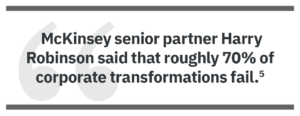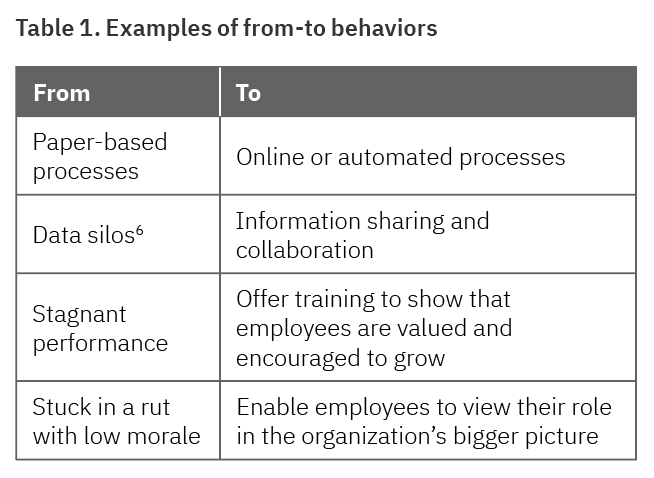By Michelle Gardner
The role of technical communicators is evolving. Those skills can be used to support new processes and procedures in an organization.
Chances are you are no stranger to change in the workplace. Maybe new technology is being introduced and you must learn a whole new software program. Perhaps there is new leadership at the helm and they are introducing a plethora of newfangled processes and procedures. Similarly, mergers and acquisitions (M&As) may mean leaving behind familiar ways of working and adjusting to unknown systems and leadership styles.
Few people like change that pushes them out of their comfort zone. Most people, when presented with change of any kind, are reluctant and may feel betrayed or frightened of what’s to come. It’s not necessarily that the change is bad, but individual interpretations of change can be a stumbling block. Emotions get in the way and without resources to share these emotions, change appears worse in the minds of those affected.
Organizational Change Examples
Harvard Business School says that organizational change can involve changing your company’s culture, people, product, infrastructure, technology, or processes. There may be anywhere from five to twelve common types of organizational change. Adaptive change makes small, incremental adjustments, fine-tuning the system but not transforming it. Transformational change is fast and dramatic. Companies often launch major changes because a serious new challenge has developed.
Most changes are in one of four areas: strategy, structure, process, or people:1,2
- Strategic change adjusts a company’s strategy to achieve its goals or even to change the mission statement in response to external demands. It may involve re-evaluating target markets, how products are sold, or business partnerships.
- Structural change involves the hierarchy of authority, goals, administrative procedures, and management systems. The change can be as simple as implementing a no-smoking policy or as involved as restructuring the entire company.
- Process changes are geared toward optimum workflow and productivity. They address time lost in repetitive or administrative tasks by implementing automation. The adoption of robotics in manufacturing is another process change example.
- People changes alter the behaviors, skills, or performance of employees to change how they solve problems, learn new skills, and perceive their role in the organization. An example is manager training to help them work effectively with their teams.
 If you find yourself at ground zero of change management, you are bearing the burden of the who, what, why, and how of the entire process. As a technical communicator, you understand customer requirements, the desired outcome, the tools you have for the job, and when your deliverables are due. In short, you can be a project manager for organizational change. If it’s not already in your repertoire, learn how to think strategically to expand your role and value as a technical communicator.
If you find yourself at ground zero of change management, you are bearing the burden of the who, what, why, and how of the entire process. As a technical communicator, you understand customer requirements, the desired outcome, the tools you have for the job, and when your deliverables are due. In short, you can be a project manager for organizational change. If it’s not already in your repertoire, learn how to think strategically to expand your role and value as a technical communicator.
What Is Strategic Thinking?
Strategic thinking is looking beyond the immediate issue to consider consequences, implications, interdependencies, and indirect effects of your decisions. Where critical thinking is the methodology used in problem solving and decision making, strategic thinking is the activity where critical thinking is the tool.3
Strategic thinking in change management is anticipating the consequences and implications of the new processes and procedures you are implementing.
Miles Kimball wrote an article in Technical Communication describing a study conducted among technical communication managers.4 Participants valued basic technical writing skills and traditional credentialing over technical degrees or certifications, yet practitioners need strategic skills to advance their careers. Technical communicators should be smart, well-trained writers, but they can also be participants in determining an organization’s strategic goals.
Onward to Change Management
People tend to resist change, but there are approaches and best practices that help calm their fears of leaving their comfort zone and venturing into the unknown.
Explain Why Change Is Taking Place
Creating tools and processes that solve business problems may be the gist of your project, but they can be an imposition on those who must use them. Demanding that your people master new concepts often results in pushback when complexity replaces familiarity. Processes should reduce complexity and improve structure.
As the technical communicator who is helping to spearhead change in your organization, be thorough and clear in explaining why the change is taking place. Create supporting materials and documentation that spell out what initiated the idea for change and why it is important for the company. Is it to achieve digital transformation and cloud-based workflows? Are you introducing automation to help employees be more productive and efficient? Do you need to adapt to the changing habits of your customers?
Get Leadership Buy-In
Successful change management is rooted in buy-in, which is based on solid reasons for change, and it should start from the top. As it filters down through the ranks, the message must remain consistent.
If the coming changes weren’t initiated by the highest-level leader(s) in your organization, getting buy-in from leadership is necessary before communicating them to the rest of the organization. Defined goals and benefits of change are imperative to get leadership aligned and to identify other individuals in the organization who can help lead the change. Recruiting other change agents will help in seeking input from those affected by the changes and incorporate their feedback into project iterations.
Communicate and Don’t Exclude Anyone
When left to their own devices, people will make assumptions about the changes taking place, rumors will run rampant, and morale will plummet.
To help avoid such negativity, communicate early, often, and with everyone. Let them know how the change will affect them, then provide ongoing status reports of the change process.
Consider how processes and procedural changes in one department directly or indirectly affect other departments and develop a plan that communicates how your company will accommodate these effects. Gather feedback from those affected by capturing their questions and concerns, fears, and insecurities. Knowing what they are thinking and feeling and making them co-creators in the change process will go a long way to alleviate tensions and gain their support as change agents.
Explain the New Behaviors Expected
Once you’ve defined why the change is taking place, you should be able to identify new behaviors the organization needs to see during and after implementing the change. Table 1 is an example of the before-and-after or from-to behaviors.
Table 1. Examples of from-to behaviors
Provide Training for Everyone
Cultural change is just as important as technological change and when there are new technologies or processes, employees must develop new habits for using the tools. Your technical writing skills will shine here since you’ll need to explain what the process is and walk people through its features and functionality.
A combination of written documentation, live and recorded training, and cheat sheets will help transition employees to the new way of working. A pilot group can prove useful here so that you can expand on or clarify the materials for various levels of learning and understanding. Be sure that documentation and training materials are updated when software or platforms release new versions and offer refresher training to make people aware of new features and functionality.
Define Benchmarks for Success
Developing key performance indicators (KPIs) for behavioral change takes work, but they are necessary for driving and measuring the right behavior in your organization. Developing KPIs include:7
- Using them to improve performance
- Considering the unintended consequences of a KPI (responding to the KPI instead of hitting its target)
- Getting a holistic understanding of organizational performance
- Improving the process for reaching goals
Consistent behaviors create cultural norms in your organization, which may include:
- Learning and improving instead of comparing and judging
- Encouraging buy-in rather than “signing off”
- Improving through leverage, not force
Best Practices for Change Management
Prosci is a global team of change advocates. Now on their 11th edition of Best Practices for Change Management,8 study participants consistently identify seven factors that impact the results of a change initiative:
- Mobilize active and visible executive sponsorship
- Apply a structured change management approach
- Communicate frequently and openly
- Engage with front-line employees
- Dedicate change management resources
- Engage and integrate with project management
- Engage with and support middle managers
Having a positive leader who actively and visibly guides the organization through change is the greatest contributor to its success. It was cited four times more frequently than the next contributor to change success.
Conclusion
Whether your organization is big or small, change is inevitable and preparing for change of any kind should be a top priority.
Change management goes deeper than teaching employees how to use a new software application or adapting to corporate restructuring. Clearly stating why change is taking place and getting buy-in from leadership are critical to its success. If leadership doesn’t buy in, people throughout the organization won’t buy in, and no one will invest the energy to make change happen.
Applying strategic thinking and following best practices for change management will help the process move along so your organization can quickly adopt new behaviors, adapt to the new way of working, and improve their workflow process.
As a technical communicator, you can evolve your role and become a strategic partner for change management in your organization. In the process, you can continue to develop your skills that will help support new processes and procedures.
References
- CliffsNotes. n.d. “Principles of Management.” Accessed 5 February 2022. https://www.cliffsnotes.com/study-guides/principles-of-management/managing-change/types-of-organizational-change
- Chron. n.d. “Examples of Organization Change.” Accessed 5 February 2022. https://smallbusiness.chron.com/examples-organization-change-11694.html
- Kallet, Mike. 2017. “Strategic vs. Critical Thinking.” Accessed 2 February 2022. https://www.linkedin.com/pulse/strategic-vs-critical-thinking-mike-kallet/
- Kimball, Miles A. 2015. “Training and Education: Technical Communication Managers Speak Out.” Accessed 5 February 2022. https://www.stc.org/techcomm/2015/07/14/training-and-education
-technical-communication-managers-speak-out/ - McKinsey & Company. 2019. “Why do most transformations fail? A conversation with Harry Robinson.” Accessed 30 January 2022. https://www.mckinsey.com/business-functions/transformation/our-insights/why-do-most-transformations-fail-a-conversation-with-harry-robinson
- Talend. n.d. “What are Data Silos?” Accessed 5 February 2022. https://www.talend.com/resources/what-are-data-silos/
- Barr, Stacey. 2021. “Steps to Create KPIs that Drive the Right Behavior.” Accessed 5 February 2022. https://www.staceybarr.com/measure-up/steps-to-create-kpis-that-drive-the-right-behaviour/
- Prosci. n.d. “Best Practices in Change Management.” Accessed 20 January 2022. https://www.prosci.com/resources/articles/change-management-best-practices
 Michelle Gardner, (https://www.linkedin.com/in/michellegardner), has more than nine years of experience as a technical writer in the tax and accounting industry and currently is a contracted senior writer at Microsoft focused on their cloud portfolio. Editing makes her world go round and she is spreading her wings in book editing, helping authors create engaging narratives for their readers.
Michelle Gardner, (https://www.linkedin.com/in/michellegardner), has more than nine years of experience as a technical writer in the tax and accounting industry and currently is a contracted senior writer at Microsoft focused on their cloud portfolio. Editing makes her world go round and she is spreading her wings in book editing, helping authors create engaging narratives for their readers.



